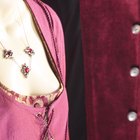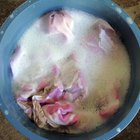
If you're bored of your old dresses, don't give them away or toss them out just yet. Instead, breathe new life into a dress by tie-dyeing it. Tie-dye was popularized in the 1960s and '70s, but the bold, bright colors and wild patterns if tie-dyeing have been achieved by various techniques for thousands of years. With this tie-dye technique, you can use any combination of colors and patterns that you'd like. Turn a plain dress into a eye-full of color with just a few dye baths and a dash of whimsy.
Step 1
Choose the right kind of fabric dye for your particular dress's fabric.
Step 2
Cover your work surface, such as a table, with a large piece of plastic or a tarp to protect it from dye stains. Work outside if you can, or in a well-ventilated area.
Step 3
Soak the dress that you want to dye in a bowl of hot water. Wring the dress dry.
Step 4
Fold or twist the dress depending on the color pattern you want. For a wavy sunburst pattern, twist the dress tightly, then wrap rubber bands around it. To make the waves larger, spread the rubber bands farther apart. For smaller waves, put the rubber bands closer together. To make a circular pattern, bunch up a small amount of fabric into a little ball, then hold it in place with a rubber band. Repeat this for as many circles as you'd like. For a wild and unpredictable pattern, scrunch the dress up as tightly as you can and wrap rubber bands around it at different angles.
Step 5
Put on a pair of rubber gloves and prepare the dye or dyes as instructed by the manufacturer. Your dye is likely to be in a liquid-concentrate or powder form and you'll need to mix it with water in a large bucket. In general, mix 1/2 cup of liquid dye or one packet of powdered dye with 2 to 3 gallons of hot water.
Step 6
Dip the part of the dress you want dyed into the dye bath and hold it there for about 10 minutes. When you're ready to move the dress, carefully remove it from the dye and hold it up above the bucket, allowing excess dye to drip off. Dip another part of the dress in a different color, if desired, and hold it there for 10 minutes. Repeat this until you've dyed the entire dress.
Step 7
Hold the dress over the sink and wring out any excess dye. Rinse the garment under cool water until the water runs clear.
Step 8
Cut the rubber bands off of the dress with scissors and hang the garment up to dry. By the time the dress dries, the dye should be set.
Step 9
Drape the dress over an ironing board or another flat surface and cover it with a towel or thin cloth. Press down on the dress with a hot steam iron to further fix the dye into the fabric. Fixing the dye will help prevent it from bleeding when you launder the garment for the first time.
Step 10
Wash the dress by hand in cold water. Depending on how well the dye has set, you may notice some color bleeding. After the initial wash, you can also launder it in the washing machine alone or with like colors. Hang the garment up to dry. Alternatively, put it in the clothes dryer on the tumble-dry cycle.
Related Articles

How to Dye a Linen Dress

How to Wash a Velvet Dress

How to Whiten a Veil

How to Dye a White Dress

How to Spray on Tie-Dye

How to Clean a Taffeta Dress

How to Dye a Black Dress

How to Clean Sequined Gowns

How to Dye Tulle

How to Dye a Silk Dress

How to Dye a Cotton Hat

How to Tie Dye Shoelaces

How to Stretch My Dress

How to Dye a Satin Dress

How to Bleach Satin

How to Change the Color of a T-Shirt

Steaming a Chiffon Wedding Dress

How to Deodorize a Prom Gown at Home

How to Remove Lipstick From a Silk Dress

How to Make a Men's Hippie Headband
References
Resources
Tips
- For more precise dye application, use squirt bottles. After preparing the dye, pour it into the bottles and squirt the color all over the dress.
- When laundering your tie-dye dress for the first time some of the color will probably bleed. Do not wash the dress with other garments at first, as this bleeding may stain them. Launder tie-dyed items in cold water to prevent fading.
Writer Bio
Melissa King began writing in 2001. She spent three years writing for her local newspaper, "The Colt," writing editorials, news stories, product reviews and entertainment pieces. She is also the owner and operator of Howbert Freelance Writing. King holds an Associate of Arts in communications from Tarrant County College.
Photo Credits
Jupiterimages/Photos.com/Getty Images